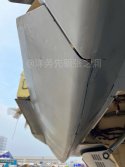You are using an out of date browser. It may not display this or other websites correctly.
You should upgrade or use an alternative browser.
You should upgrade or use an alternative browser.
2024 Zhuhai Airshow main thread, Air Systems
- Thread starter Deino
- Start date
Looks like a chonkier version of LRASM/JASSM, lol - Or maybe that's caused by photograph issue.
Probably a VLO cruise missile, with the designation CM-98. Posted by @马妍 on Weibo.
View attachment 138375
That looks identical to AKF-98 from Zhuhai 2022
Well, that's what I'm asking! The UAV mentioned in the PLAAF press briefing along with the J35A and HQ19.Which one?
Well, that's what I'm asking! The UAV mentioned in the PLAAF press briefing along with the J35A and HQ19.
I thought there was already one shown!
Is this AESA radar or PESA?
Is this AESA radar or PESA?
none, it’s not a radar but ballast
In the F-35 and F-22 they cover these areas which have fasteners and gaps with tape. And that is supposed to make it better.
Every time they need to access something internally they have to remove the tape, unfasten the fasteners, and put the tape back on afterwards.
This is an F-22 without the tape in it. You can see the holes for the fasteners, which uninformed people call "screws".

The coatings in the F-22 are way less resistant to wear and tear and peel off more easily than the thick paint the Russians use.
Here you can see the holes for the fasteners on an F-35.

Did people think the US aircraft were glued together or what? They still use fasteners just like other aircraft.
It is normal that this aircraft has a rough finish even with the coatings. Until they finished the robotic painting facility at KnAAPO a couple years ago the coatings were applied by hand. This is T-50-7 so it predates that.
With the prototypes, only starting with the T-50-11 does it look like a serial production aircraft, earlier prototypes are much rougher.
You can add more coatings to the Su-57 for extra stealth during combat but they are typically not installed while the opposite is the case with F-35 and F-22.
This is just representative of a higher degree of manual labor in production in Russia. Because they have less automation in production you will have a higher amount of small defects.
It is still the 5th generation airframe with higher degree of agility and most complex control mechanism. It has the most controllable surfaces including the LEVCONs and TVC in the engines. And it has longer internal storage than the US aircraft which means it can carry large cruise or air to air missiles internally unlike either of the US aircraft.
Every time they need to access something internally they have to remove the tape, unfasten the fasteners, and put the tape back on afterwards.
This is an F-22 without the tape in it. You can see the holes for the fasteners, which uninformed people call "screws".

The coatings in the F-22 are way less resistant to wear and tear and peel off more easily than the thick paint the Russians use.
Here you can see the holes for the fasteners on an F-35.

Did people think the US aircraft were glued together or what? They still use fasteners just like other aircraft.
It is normal that this aircraft has a rough finish even with the coatings. Until they finished the robotic painting facility at KnAAPO a couple years ago the coatings were applied by hand. This is T-50-7 so it predates that.
With the prototypes, only starting with the T-50-11 does it look like a serial production aircraft, earlier prototypes are much rougher.
You can add more coatings to the Su-57 for extra stealth during combat but they are typically not installed while the opposite is the case with F-35 and F-22.
This is just representative of a higher degree of manual labor in production in Russia. Because they have less automation in production you will have a higher amount of small defects.
It is still the 5th generation airframe with higher degree of agility and most complex control mechanism. It has the most controllable surfaces including the LEVCONs and TVC in the engines. And it has longer internal storage than the US aircraft which means it can carry large cruise or air to air missiles internally unlike either of the US aircraft.
Last edited:





